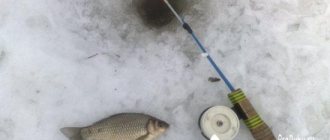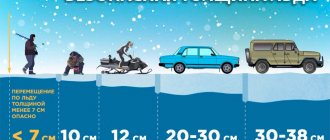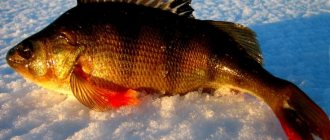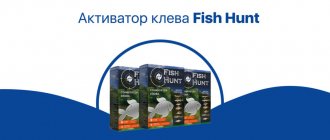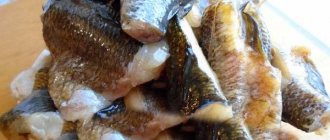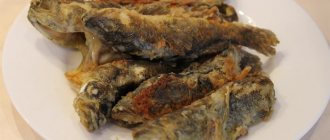Winter fishing is an exciting and varied activity. It differs from summer fishing methods and fish activity. Unlike summer, in winter fish bite less actively and change habitats. There are situations when the bite disappears for no reason, regardless of the method and in what part of the reservoir you are fishing.
But even in such cases, one greedy and gluttonous species remains. Which with equal eagerness attacks the bait both at the beginning of December and in the middle of the dead winter - rotan (or, as it is also called, firebrand). This is a small predatory fish that quickly spread throughout the European part of Russia. The article talks about fishing for rotan and its habits: what gear to use, how to lure and other features.
Prey, on the ice in winter
What baits to use to catch rotan in winter
Rotan is a predatory fish; animal baits are used to catch it. He is not picky in his choice of food, but at the same time he loves some baits more than others. If the goal of fishing is to catch as many as possible, you need to know what kind of food he prefers. The best bait for rotan in winter is chicken skin. Especially from the back of the chicken, where there is more fat.
How this bait is made:
- The skin is removed from raw chicken.
- It is cut first into strips and then into squares.
- Places on the hook.
- You can cut the skin into elongated triangles in the form of small “teeth”.
- The triangles are twisted and placed on the end of the hook in a twisted form.
This type of bait holds better on the hook; you can use several pieces during a fishing session if the bite is active. If rotan is not active, then you need to often replace the skin with a new one so that it constantly smells like chicken fat. The predator likes this smell, and its light color attracts attention in muddy and dark water.
Chicken skin on a jig - for fishing in winter.
It can also peck on pieces of raw fish or even lard. Well, hooks with traditional baits like maggots or bloodworms are also often attacked. It’s better to take several types of bait with you, experiment on the spot and select a catchy option.
What gear and equipment to choose for catching rotan in winter
Rotan can be caught with any tackle using any fishing rod. At this time, the bait is attacked by small specimens of it, which can be caught with the thinnest tackle. Unlike other types of fish that are alarmed by thick fishing lines, rotan is not afraid of thick fishing lines and can be safely caught on fishing line with a diameter of 0.2 mm.
Every fisherman knows how difficult it is to work in the cold with a very thin fishing line, and therefore using such a fishing line will make the fisherman’s task somewhat easier. As a fishing rod, you can use a winter fishing rod of the “telephone” or “balalaika” type. The optimal diameter of the fishing line is 0.08-0.16 mm. A thinner line is chosen for catching rotan in the dead of winter, and a thicker line is used for catching it on the first and last ice.
Equipment and gear for fishing on the first ice and during other periods
Different types of gear are suitable for catching firebrands in winter. During this period, it is impossible to catch rotan of size (above 150-200 grams), you can use light equipment and fishing rods. A winter fishing rod will do.
Any thickness of fishing line can be used because, unlike most other fish species, this predator is not afraid of the diameter of the fishing line. You can even fish with a thread 0.2 millimeters thick. But this makes no sense, so standard sizes of fishing lines for winter fishing are used (0.08-0.14 mm).
When choosing a fishing line, you can rely on what period of winter the fishing will take place. So, at the beginning and end of winter it is more active, you can choose a fishing line of greater thickness. In the middle of nowhere, on the contrary, activity decreases, therefore the fishing line is chosen with a smaller diameter.
Fishing rods for winter fishing on rotan
Fishing rod - winter balalaika
As was said, the fishing rod can be used in any shape. It could be a “telephone” or a “balalaika”. A fishing rod for winter fishing on rotan consists of several parts:
- coils;
- whip;
- and a nod.
Any reel will do, because it is only needed to store fishing line. The body of the rod (whip) should be rigid and elastic. This makes hooking sure and reduces the chance of the trophy falling off the hook.
The bite is sharp, and the nod should also be hard. Such a nod will not only more clearly show attacks on the hook, but will also allow you to play with heavier baits (like a jig with bait attached to it)
Balalaika fishing rod for winter
Selecting line diameter
The fishing line can be used in any size and thickness. In winter, monofilament thread with a diameter of 0.12 - 0.16 millimeters is more often used. The thickness is taken with a large margin, because they are afraid that a specimen of trophy size will be caught on the hook. Or they are not confident that they will be able to carefully hook and fish.
But with the right technique, in order to pull the rotan to the surface of the ice, a fishing line up to 0.1 millimeter thick is enough.
Ice fishing line
Spinner for rotan in winter
One way to catch firebrands in winter is by lure fishing. There are no special types of spinners for this species. Any fishing tackle in the box is suitable for fishing. For fishing, the same spoons are used that are used to catch perch. These can be pieces of iron up to 5 centimeters in length with one hook at the end. On the first and last ice you can also fish with a bare spoon - at this time rotan is active.
But in the dead of winter, it’s unlikely to bite on empty bait. Therefore, in the middle of winter, the spinners are covered with flavorings. These can be store-bought formulations or natural substances. Some people rub the body of the spoon with the meat of already caught fish. Also, if you don’t want to smear the spoon with something, you can attach an animal bait like this to the hook:
- bloodworm;
- maggot;
- chicken skin.
It must be remembered that rotan primarily relies on its sense of smell and choose bait based on this factor.
Spoons for winter
Balancer - the best bright tackle
The situation with fishing with a balance beam is the same as with a spoon: small-sized gear is suitable for winter. It is caught on balance beams up to 40 millimeters in length (including hooks). Color does not greatly affect the bite; the firebrand relies little on vision and is guided by smells.
But if you have a choice, then it is better to take brightly colored fishing tackle to make it easier to notice not only rotan, but also other species. Although it bites on any tackle, it prefers the balancer least of all due to the peculiarities of the game.
This type of fish prefers playing with vertical wiring.
Balancers for winter, as an element of successful fishing
Mormyshka is the best way of fishing
Most often, firebrands are caught on ice using jigs. This is due to the fact that jigs are varied in shape and size. You can attach any type of bait to them and diversify the movements with an interesting game. It is also small in size and does not scare off small individuals. Among all forms of jigs, the following types are most often used:
- devil;
- nailball;
- drop;
- pellet;
- Nymph.
Although, depending on the reservoir and external factors, fish preferences may change. You need to have several types of jigs with you and choose on the spot, based on the bite activity for each of them. Additionally, you can use a nozzle of animal origin.
Jigs for fishing in winter
Fishing for girders and rigs - how to catch a trophy specimen
Rotan is caught on girders not for the sake of the quantity of catch, but for sporting interest. When fishing with baits in winter, you come across trophy sizes. If there is a pike in the pond, then it is better to use a steel leash to reduce the chance of the line being cut. Live bait is attached through the gills. This method of fishing eliminates the possibility of empty bites. Read how to store live bait in another article.
To increase the chances, several girders are placed in different places of the reservoir at different depths. In this case, they are left for a long period of time. Fishermen use the hooks as auxiliary gear and do not touch them throughout the entire fishing trip.
Zherlitsa for winter fishing - photo of a fisherman from Krasnoyarsk
Ice fishing for rotan
Winter fishing for this greedy predator is specific. This is due to the habits of the predator and the conditions of the reservoirs. The firebrand is caught all winter if the reservoir does not freeze completely. The most active biting is observed at the beginning and end of winter, but in the dead of winter the predator is passive. More information about largemouth habits, habitats and fishing methods:
Bait for winter fishing for rotan is not always used. During periods of hunger, this predator is caught with a bang. However, there are times when it is better to attract it using additional methods other than bait on a hook. This operation sometimes significantly improves the bite.
What to feed is the best way to attract firebrands
Not only the correct selection of gear, but also well-made feeding has a great influence on the biting activity. To understand how to lure, you need to know their diet and habits. This is a predator, so you need to use bait of animal origin.
A simple way to feed and attract the attention of firebrands is to throw a piece of raw meat into the hole. An attractive smell will emanate from it for a long time, and only a very large individual will be able to eat such bait. Additionally, you can use another animal component:
- meat and fish remains;
- tripe;
- intestines.
If only small individuals are found in the pond, then you can use food bloodworms or maggots. Or finely chop the already caught rotan and send it to the hole.
Feed bloodworm - effective during winter
Fishing technique - proper jig play
First you need to drill a large number of holes (from 10 to 20 pieces). They are drilled from the shore to the center of the reservoir in a regular or checkerboard pattern. After this, each of the holes is fished. On one hole, it is enough to make 4-5 entries to understand whether there is rotan under the ice.
If there was not a single bite, then most likely there are no fish below, and you need to move on to the next hole. If the holes are completed and no rotan is found in any of them. You need to move on to drilling the next holes, and so on until a flock comes across.
Playing with a jig when fishing is simple - you need to throw the bait a short distance from the bottom (no more than 40 cm). This is done at intervals of 2-3 seconds. When biting, you don’t have to hook, because this fish swallows the bait deeply and reliably. For the same reason, fishermen take a hook extractor with them.
Extractor for fishing hooks, used in both winter and summer
Features of fishing at night
The main feature of fishing for rotan at night is the lack of bite. Seriously, the chances of catching even a small fish at night are close to zero, not to mention trophies. If you want to check how many fish it is possible to catch during this period, you can try placing bait baits and leaving them overnight. And then, with a high probability, bites will occur in the evening and morning dawn.
If you want to try fishing with a fishing rod, it is better to use a luminous nod rather than a lighting device. Because the light can scare away even the small number of fish that are interested in the bait.
What gear and equipment to choose for catching rotan in winter
Rotan can be caught with any tackle using any fishing rod. At this time, the bait is attacked by small specimens of it, which can be caught with the thinnest tackle. Unlike other types of fish that are alarmed by thick fishing lines, rotan is not afraid of thick fishing lines and can be safely caught on fishing line with a diameter of 0.2 mm.
Every fisherman knows how difficult it is to work in the cold with a very thin fishing line, and therefore using such a fishing line will make the fisherman’s task somewhat easier. As a fishing rod, you can use a winter fishing rod of the “telephone” or “balalaika” type. The optimal diameter of the fishing line is 0.08-0.16 mm. A thinner line is chosen for catching rotan in the dead of winter, and a thicker line is used for catching it on the first and last ice.
Favorite habitats of rotan
Rotan is a greedy fish, so in places frequented by fishermen, it is almost impossible to find large specimens of this species. If you want to find a place with large specimens, you need to try hard. Large individuals live in remote ponds and lakes. If you are lucky enough to come across one, you can count on a rich catch.
In the reservoir itself, the firebrand should be looked for in polluted places where there is a lot of silt, reeds and other vegetation. He also loves snags and fallen trees. In the dead of winter you need to look at depth, but at the end of November and beginning of March it is located near the shore.
In which regions is rotan caught from ice?
This type of fish was brought from Amur. Several of its individuals ended up in a river in the Moscow region, after which it began to quickly spread throughout Russia. It easily takes root in almost any conditions, reproduces quickly and is not picky about food, which is why many consider rotan a trash fish. Only pike and fishermen who take advantage of its active bite and catch large numbers every season can stop the population growth.
Rotan has spread throughout Russia; you can fish from ice in any region where there is this ice, be it Yekaterinburg near the Urals or deep Siberia.
Fishing for rotan
Until recently, rotan (firebrand) was considered an exclusively weedy and harmful fish, knocking out the usual microflora of small ponds and overgrown oxbow lakes. In some ways, this opinion seems correct, however, this is only at first glance. In the 50s of the last century, the population of this omnivorous predator of standing reservoirs of the Amur Basin began a victorious march through the ponds of the European part of Russia.
- Getting into a new body of water, the firebrand (due to its vitality and predation) destroyed the populations of local crucian carp (and other fish), completely taking over the water area. Now this species is present throughout the country, including the Urals and Siberia.
- Over time, the viral spread faded away - the fish simply occupied an ecological niche. The guest does not take root in every body of water. And he doesn’t always manage to survive. The food of this predator is so greedy that in water bodies visited by fishermen the population is often completely caught.
- Secondly, with a large population of pike, the firebrand is quickly destroyed by the toothy one. The Far Eastern guest simply does not know how to hide, since there were no pike in the places where he evolved. Now there are already many ponds and creeks where this fish has occupied a niche and lives peacefully with crucian carp and other inhabitants.
- Catching rotan in winter is of interest due to the availability and high gastronomic qualities of the fish. The meat of this fish is white, without small bones. When fried, it is sweeter than that of the same crucian carp. Fish soup, sprats, pickling and drying - firebrand is good in any form.
- The only drawback is the size of the fish. Many ponds are inhabited by finger-sized specimens. However, in feeding ponds and good conditions, some specimens reach impressive sizes - up to 400 grams. Occasionally there are individuals weighing up to 1 kilogram and up to 50 centimeters long.
- For successful catching of rotan in winter from ice, many reservoirs are available throughout the country. This fish thrives in oxygen-poor, overgrown puddles. The firebrand survives and reproduces where no other fish have ever been. Therefore, fishing for this fish is an excellent option for city residents who do not have access to normal rivers and lakes.
- There is no difficulty in fishing - the main thing is to find the right body of water. The rotan bites on simple and rough tackle without any frills. Of course, there are some peculiarities – we’ll look further at when rotan bites in winter. Fishing rod rigging is secondary. The main thing is to understand how rotan overwinters and what it eats.
Determining the bite of rotan using a barometer
Rotan, like any fish, is sensitive to atmospheric pressure. Before you go fishing, it is better to see what the pressure was in the previous days. Based on this, decide whether to go fishing or wait until the situation improves. Most of all, he doesn't like unstable, fluctuating pressure. At such moments you can’t count on a good bite. He also doesn't like low or slowly rising blood pressure. But with high and medium pressure, you can already be prepared for the fact that there will be active pecking. Rating of TOP 10 barometers for fishing.
But the firebrand bites better in cases where the pressure has dropped slowly and steadily over the past few days.
Determining the bite using the barometer
How rotan behaves in winter
The very first high activity of rotan in winter appears on closed reservoirs at the beginning of the season, when the ice has just frozen; on open reservoirs, the ice becomes a week or two later, so if you get bored of catching rotan on lakes, you can safely move to other reservoirs. In the middle of winter, rotan is inactive and takes bait very reluctantly.
Later, when the ice thaws, when it becomes like during the first severe frosts, rotan again shows its former activity. When the ice is thin, rotan, both large and small, gathers closer to the shore; after one or two weeks, when the ice reaches a thickness of 14-16 centimeters, large specimens of rotan go to the depths, trying to stay on the edge of underwater thickets, in snags, while small specimens also continue to be in shallow water.
Rotan is not afraid of complete freezing of a reservoir, since due to its physiological characteristics it is capable, when freezing in ice, of forming a “gas chamber” around itself, which contains oxygen. After which the fish goes into suspended animation, emerging from it when the ice thaws.
It is noteworthy that rotan is not afraid of the noise of an ice ax, so even after drilling a hole directly above its head, there is a chance to immediately pull out the first catch.
After the ice reaches a thickness of more than 30 centimeters, rotan goes into the pits, where you should look for it among the thickets of grass. It should be remembered that small individuals live in packs, while large ones hunt alone. Rotan is most active during the daytime (from morning to lunch inclusive), after which the bite sharply worsens, and at night you may not catch anything at all.
The most successful weather for winter fishing will be a cloudy day with high atmospheric pressure, since rotan does not like sunlight. When the weather changes abruptly, the fish loses its appetite, so you should choose a day from a stable weather week for fishing. During the full moon, rotan may not take bait at all, while immediately after the moon changes the situation changes dramatically.
